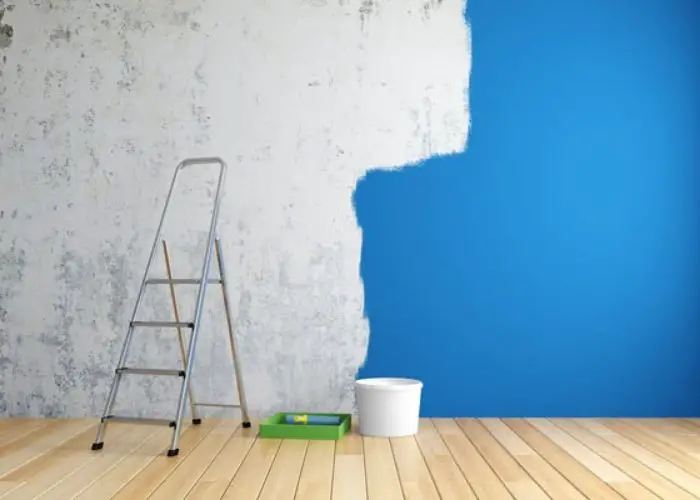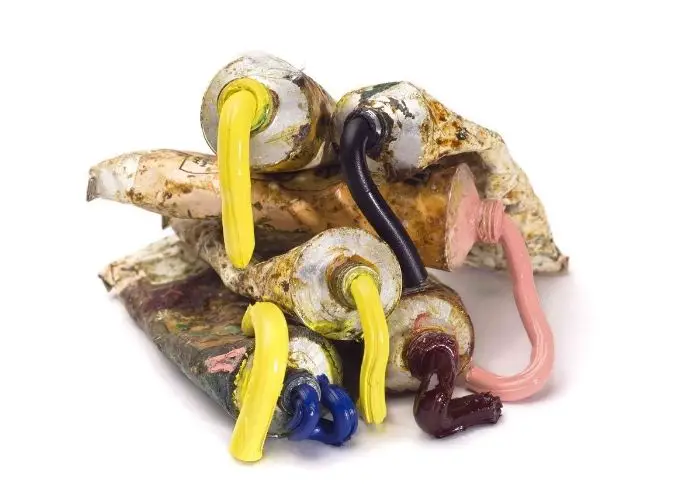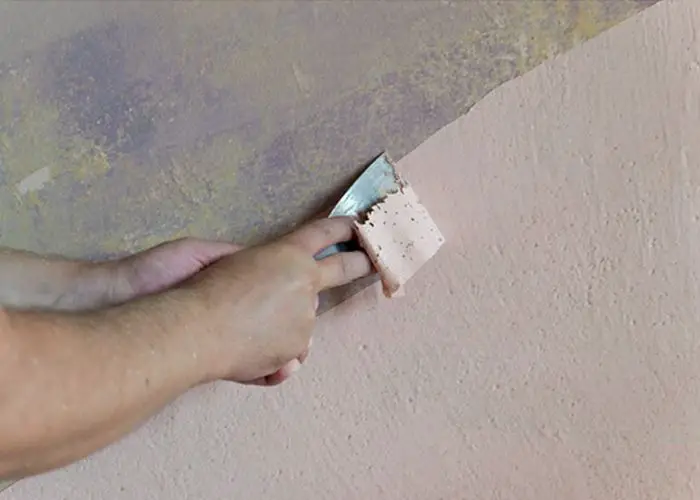Whether you’re a professional painter or just someone who likes to do a bit of painting on the weekend, you may be asking yourself this question ‘can you use acrylic paint on walls?’.
The answer is yes – acrylic paints can be used on walls, that is why many artists choose acrylic paint as their go-to paint for wall murals and wall art, but there are some things you need to keep in mind when doing so.
In this blog post, we’ll look at what those things are and provide some tips for successfully using acrylic paint on walls.
Can You Use Acrylic Paint on Walls?
Yes, acrylic paint can be used on walls. The best acrylic paint for wall painting is 100% acrylic latex paint, which can provide good coverage and durability. Acrylic paint can be used on other surfaces such as wood, metal, or glass. Luckily, you can learn how to remove dry paint from glass and other surfaces alike.
What Are the Things to Keep in Mind When Using Acrylic Paint on Walls?
There are a few things you need to keep in mind when using acrylic paint on walls:
- Make sure the surface is clean and dry before painting. Acrylic paint will not adhere well to a dirty or wet wall.
- Use a primer before painting walls. This will help the paint to stick to the surface and provide better coverage.
- Paint in small sections at a time. This will help the paint dry evenly and prevent it from dripping or running.
- Use a brush or roller specifically designed for use with acrylic paint. This will help to create a smooth, even finish.
With these tips in mind, you’ll be able to use acrylic paints on walls in your home successfully. Remember to take your time and work in small sections for the best results.
Is Acrylic Paint Good For Interior Walls?

If you’re considering painting your interior walls with acrylic paints, you might be wondering if it’s a good choice for your home. There are a few things to consider when making your decision.
First, acrylic paint is known for being durable and easy to clean, making it a great choice for high-traffic areas or rooms where spills are likely to happen.
It also has a relatively fast drying time, so you won’t have to wait long to enjoy your new paint job.
On the downside, acrylic paints can be more expensive than other types of paint, and it doesn’t always provide the same level of coverage as latex paint.
But if you’re looking for a tough and low-maintenance option, acrylic is definitely worth considering.
On the other hand, If you are looking for a long-lasting paint job, consider using oil based paints instead.
Can You Use Acrylic Paint on Outside Walls
There is no definitive answer to this question as the best way to use acrylic paints on an outdoor wall will vary depending on the surface material, climate, and other factors.
However, in general, acrylic paint is a good option for outdoor walls as it is durable, weather-resistant, and affordable. And can you add acrylic paint to wall paint? Find out.
Can You Use Acrylic Paint on Bathroom Walls
Yes, acrylic paints can be used on bathroom walls. There are a few things you should consider before painting your bathroom walls with acrylic paint.
Bathrooms are typically damp and humid environments, which can cause the paint to peel or crack. But don’t worry; here is how to prevent acrylic paint from cracking.
In addition, the high level of moisture in the air can also cause the paint to fade over time.
If you decide to go ahead and use acrylic paints on your bathroom walls, be sure to apply a coat of primer first.
This will help the paint adhere to the surface and will also help to protect it from moisture.
What Happens If You Paint Walls With Acrylic Paints?
If you paint walls with acrylic paints, the color can last for years. However, if you don’t use a primer or if you don’t clean the surface before painting, the paint can start to peel within a few months.
It’s also important to note that acrylic paint can be difficult to remove once it’s on a wall.
Here is a guide on how to get acrylic paint off concrete walls.
So, if you’re not sure you want to commit to a certain color, it’s best to test it out on a small section of the wall first.
Overall, painting with acrylic paints can be a great way to add color and personality to your home.
Just be sure to take the necessary precautions beforehand so that the paint will last for years.
How Long Does Acrylic Paint Last On Walls?
We often get asked this question, and it depends on a few different factors. For example, the type of paint you use will make a big difference.
There are specially formulated “acrylic latex” paints designed to last longer on surfaces like walls. In addition, these acrylic paints usually come with a warranty of 10-15 years.
Other factors that will affect how long your paint job lasts include the climate you live in and how well you take care of your painting.
For instance, if you live in an area with high humidity, your paint job may not last as long as it would in a drier climate.
And if you regularly wash your walls or expose them to harsh cleaning chemicals, that will also shorten the paint’s lifespan.
But if you use high-quality acrylic latex paint and take basic care of your walls, you can expect your paint job to last for more than 10 years.
Why Does Acrylic Paint Go Bad?

Like all types of paint, acrylic paint can go bad over time. The most common cause of premature deterioration is exposure to air and light.
Oxygen and ultraviolet light cause the pigments in the paint to break down, resulting in a loss of color and vibrancy.
In addition, changes in temperature and humidity can also lead to changes in the consistency of the paint, making it brittle and flaky.
To extend the lifespan of your acrylic paints, it’s important to store them in a cool, dark place when not in use.
How Long Does Acrylic Paint Take to Dry on Walls?
The acrylic paint drying time depends on a number of factors, including the type of paint used, the thickness of the paint, the amount of ventilation in the room, and the humidity levels.
However, you can expect acrylic paint to take anywhere from two to four hours to dry on walls fully.
How Long Does Acrylic Wall Paint Take to Cure?
Acrylic painting on a wall will take 24 to 48 hours to cure completely. But you can do a few things to speed up the curing process. Firstly, make sure you’re using high-quality paint.
Secondly, apply a thin layer of paint rather than trying to cover the entire surface in one go. And finally, provide plenty of ventilation by opening windows and doors or using a fan.
Interesting Read: How to Paint a Guitar With Acrylic
How to Apply Acrylic Paint to a Wall?
There are a few things you need to know before you apply acrylic paint to a wall.
You need to choose the right paint for the surface you are painting, and you need to prepare the surface properly.
Here’s how to do acrylic painting on a wall:
Materials and tools needed:
- High-quality acrylic paint
- Roller
- Ladder
- Paintbrush or roller
- Tape (optional)
Step 1: Prepare the surface
If you’re painting over an existing wall, wash it down and remove any loose paint or debris. Sand it down to create a smooth surface if you’re starting with a new wall.
Step 2: Apply a base coat of paint
Once the surface is prepared, apply a base coat of paint. This can be either a primer acrylic paint or an all-purpose primer.
This will help the paint adhere better to the wall and also provide a barrier between the paint and the wall itself.
Step 3: Start painting
Now you’re ready to start painting! Take your painting brush or roller and start the job. If you’re using a roller, start to apply acrylic paint at the top of the wall and work your way down.
If you’re painting with a brush, start in one corner and work your way around the room. Next, use a roller to apply the paint in even strokes.
For best results, apply two coats of paint, allowing each coat to dry completely before adding the next.
Step 4: Finish up
Once you’ve finished painting, remove any tape (if used) and allow the paint to dry completely. And that’s it! You’ve now successfully applied acrylic paint to a wall.
See Also: Can You Sublimate on Acrylic Paint
How to Seal Acrylic Paint on Wall?
Once your paint is dry, you’ll need to seal it in order to protect it from dirt, dust, and other environmental factors. You can use either a clear acrylic sealer or a varnish.
Most walls are made of a Matte surface, so it can be tricky to know how to seal your newly painted wall.
You don’t want to use a high-gloss sealer because that will make the paint look shiny and new. A good rule of thumb is to use the same Sheen as the paint you used on the wall.
For example, if you used an eggshell finish paint, then you would want to use an eggshell sealer.
For best results, apply two coats of sealer, allowing each coat to dry completely before adding the next.
You may need to wait a few minutes for the sealer to dry completely before moving on to the next step.
But once it’s dry, your newly painted wall will be protected from dirt and stains.
Now find out what’s best between flat vs eggshell paint.
How Long After Painting Can You Hang Things?
With most types of paint, it’s best to wait at least 24 hours before adding any type of hardware or décor.
This gives the paint plenty of time to dry and prevents any accidental fingerprints or smudges.
However, acrylic paints tends to dry a bit quicker than other types of paint. As a result, you may only need to wait for about 12 hours before hangings things on the wall.
How Long Should You Wait Before Sleeping in a Room that has been Freshly Painted with Acrylic Paint?
While the paint is still wet, it is important to allow adequate ventilation in the room to prevent the build-up of fumes.
However, it is generally safe to sleep in the room once the paint has dried. It is important to test a small area of the paint first to ensure that you are not allergic to the fumes.
In general, it is best to wait at least 24 hours after painting before sleeping in the room. This will give the paint time to dry fully and allow any fumes to dissipate.
Will Acrylic Paint Wash Off the Wall?
Yes, but it may take some elbow grease. For example, if you were to use high-quality acrylic paint on a wall in your home, the paint would likely adhere to the surface and not wash off easily.
But, if you used a lower-quality acrylic paint, or if you did not properly prepare the surface before painting, it is possible that the paint could start to peel or chip off over time.
If this happens, you may need to use a bit of force to remove the paint from the wall.
Why Is My Acrylic Paint Not Sticking to the Walls?
Most people choose to use acrylic paints because they are known to be durable and have a great capacity to adhere to surfaces.
However, sometimes you may find that your paint does not seem to be sticking to the wall as well as you’d like it to. If this is the case, there are a few potential reasons why.
One possibility is that the surface you’re painting is not properly prepared. For example, acrylic paints need a smooth, non-porous surface to grip onto. If you have some bumps, here is how to fix chunky wall paint.
So, if you’re painting over a textured wall or a surface that has been previously painted with an oil paint, the acrylic paint may not have anything to hold onto.
Another possibility is that the paint itself is old or of poor quality. Acrylic paint can begin to thicken and dry out over time, making it more difficult to apply evenly.
If you suspect this might be the problem, try thinning the paint with water before applying acrylic paint layers to the surface.
Lastly, humidity can also cause acrylic paints to have trouble drying and adhering properly. If possible, try to keep the room you’re painting well-ventilated and cool while the paint dries.
Tips for Using Acrylic Paint on Wall
Painting your walls with acrylic paint can give your home a fresh, new look. Here are some tips to keep in mind when using this type of paint.
- Because it is water-based, it will take longer to dry than other types of paint. This means that you’ll need to be patient and allow plenty of time for the paint to set before moving on to the next step.
- It’s important to use good-quality brushes and rollers when applying acrylic paints. Otherwise, you may end up with streaky or uneven coverage.
- Don’t forget to seal the paint once it’s dry. A layer of varnish will help protect the finish and ensure that your new paint job lasts for years to come.
Interesting Read: Can I Use Acrylic Paint on Shrinky Dinks
Best Acrylic Paint for Walls
Deciding which acrylic paint is best for walls depends on what you’re looking for in a paint.
For example, if you want an acrylic paint that will provide good coverage and be durable, you’ll want to look for a thicker paint.
Thicker paint will also be less likely to show imperfections on the surface of your walls.
On the other hand, if you’re looking for acrylic paints with a high level of pigment, you’ll want to choose a paint with a higher concentration of pigment.
The downside to using a higher pigment concentration is that it can be more difficult to work with and may not provide as smooth of a finish.
Again you’ll need to decide whether you want a matte or glossy finish. Matte finishes are more popular for walls, as they tend to be more forgiving of imperfections and offer a more natural look.
However, glossy finishes can also be very effective, especially in high-traffic areas where a bit of extra durability is needed. Here’s a guide on how to make acrylic paint look glossy to help you out.
When it comes to choosing the actual paint, a few different brands are known for their quality products.
Some of the most popular brands include Liquitex, Golden, and Blick. Each of these brands offers a wide range of colors, so you should be able to find something that will suit your needs.
Is Acrylic and Wall Paint The Same?
No, acrylic and wall paint is not the same. Acrylic paint is a type of plastic made from polymers, while wall paint is typically made from latex.
Acrylic paint is durable and has a great capacity to adhere to surfaces. In contrast, wall paint is generally less durable and may not adhere as well to certain surfaces.
Is Acrylic Paint Good For Indoors?
Although this may be a matter of personal opinion, there are some objective pros and cons to consider when making your decision.
One clear advantage of using good quality acrylic paint indoors is that it dries very quickly compared to other types of paint.
This can be a great time-saver if you’re working on a project with a tight timeline.
However, some people find that the fast-drying nature of acrylic paint makes it difficult to work with, as it can be tricky to achieve smooth, even coverage.
Another downside of acrylic paint is that it can emit strong fumes when wet, so it’s important to ensure adequate ventilation in the room where you’re painting.
On the plus side, acrylic paint is very versatile and can be used for a variety of different projects as compared to other paints such as oil based paints.
So, whether you’re looking to add a pop of color to your walls or create a masterpiece for your coffee table, acrylic paint may be what you need.
What Type Of Paint Is Best For Interior Walls?
A few different types of paint can be used for interior walls, but the most popular choices are latex paints and acrylic.
Latex paint is a water-based paint that is known for being easy to work with and having a wide range of colors.
Acrylic paint is also water-based, but it contains polymers that make it more durable and resistant to fading.
When choosing a paint for your interior walls, it’s important to consider the room’s purpose.
For example, if you’re painting a bathroom or kitchen, you’ll want to choose a paint that can withstand high humidity levels.
On the other hand, if you’re painting a bedroom or living room, you may be more concerned with choosing a paint that is easy to clean such as oil based paints.
Are There Downsides to Using Acrylic Paint on Walls?
While this type of paint has many benefits, there are also a few potential drawbacks to keep in mind.
- Acrylic paint can be tricky to work with. It dries quickly, so it’s important to apply it evenly and carefully. This can be difficult for inexperienced painters or those working in areas with high humidity.
- Acrylic paint can be expensive, especially if you’re planning on painting a large area.
- Acrylic paint can be less forgiving than latex or oil based paint if you make a mistake while painting.
How to Remove Acrylic Paint on Wall

There are several methods that can be used to remove acrylic paint, but the most effective method will depend on the type of paint, the surface, and the amount of paint that needs to be removed.
You can use a paint scraper, a putty knife, or a wire brush. You can also use a chemical remover, such as acetone or lacquer thinner to rubbing alcohol.
The following are some tips on how to remove acrylic paint from your wall:
- Try using a hairdryer to loosen the paint.
- Soak a cloth in rubbing alcohol or acetone and use a wire brush to scrub the paint off the wall.
- Apply a layer of petroleum jelly to the paint and let it sit overnight. The next day, use a paint scraper or a putty knife to remove the paint.
Read More:
Can You Use Acrylic Paint On MDF?
Can You Use Acrylic Paint on Clay
FAQs
Is it ok to paint on walls with acrylic paint?
Yes, you can paint your walls with acrylic paint. However, it will take longer to dry than other types of paint, so you’ll need to be patient and allow plenty of time for the paint to set before moving on to the next step. Additionally, use good-quality brushes and rollers for the best results.
Which paint is best for wall art?
There is no definitive answer to this question, as it depends on your personal preferences and the project you’re working on. However, many people find that acrylic paint is a good choice for wall art because it’s easy to work with and can be purchased in a wide range of colors.
Is acrylic paint water or oil based paint?
The majority of acrylic paint is water-based. However, there are some oil based paints on the market. Oil based paint is more durable and less likely to yellow over time, but it can be more difficult to work with.
Can you paint over acrylic paint on wall?
Yes, you can paint over acrylic paint on walls. You will need to use a primer first, then you can use any type of paint over it.
Can you mix acrylic paint with oil paint?
Generally, mixing acrylic paint with oil paint is not recommended due to their different drying times and compositions. Acrylics are water-based and dry quickly, while oils are oil-based and dry slowly. This discrepancy can lead to cracking or peeling when the two types are combined. For best results, it’s advisable to use them separately.
Can you use acrylic paint on concrete?
Yes, you can use acrylic paint on concrete. It adheres well, but the surface must be clean and dry. Sealing the painted area with a suitable sealant afterward can enhance durability and protect the artwork from weather conditions and wear.
Can acrylic paint be used on plastic?
Yes, acrylic paint can be used on plastic surfaces. However, it is recommended to use acrylic paint specifically formulated for plastic to ensure better adhesion and long-lasting results.
Conclusion
As you can see, there are a few different things to consider when deciding whether or not to use acrylic paint on your walls.
So, can you use acrylic paint on walls? Acrylic paint is generally durable and can resist fading and chipping, making it a good option for high-traffic areas or areas that might get a lot of wear and tear.
However, it is also worth noting that acrylic paint can be tricky to work with and can often require multiple coats to achieve full coverage.
Ultimately, the decision of whether or not to use acrylic paint on your walls is up to you and will depend on your specific needs and preferences.
Whichever type of paint you choose, be sure to follow the manufacturer’s instructions carefully in order to achieve the best results.
We hope this article was helpful. Feel free to leave a comment below!










Leave a Reply